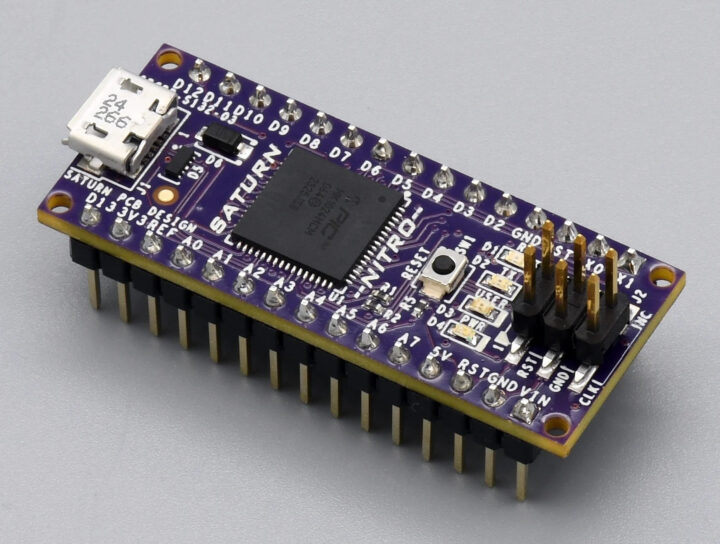While Microchip regularly releases PIC32 microcontrollers and evaluation kits, we don’t see that many PIC32 development boards from third parties. The SATURN NITRO is an exception, and the Arduino Nano-inspired development board is equipped with a 120 MHz PIC32MK general-purpose and motor control 32-bit MIPS microcontroller with 256KB SRAM, 1024KB flash, and 4KB EEPROM.
The board closely follows the design of the official Arduino Nano board and can be seen as a beefed-up version with a much more powerful microcontroller delivering 198 DMIPS compared to the Microchip ATmega328P 8-bit microcontroller @ 16 MHz with just 2KB SRAM, 32 KB flash, and 1KB EEPROM, and a less capable I/Os.
SATURN NITRO specifications:
- MCU – Microchip PIC32MK1024MCM064
- Core – MIPS32 microAptiv MCU core @ 120 MHz with FPU; up to 198 DMIPS
- Memory – 256 KB SRAM
- Storage – 1MB flash, 4KB EEPROM
- USB – 1x Micro USB OTG port also used for power
- Arduino Nano headers
- I2C, IrDA, LIN bus, PMP (Parallel Master Port), SPI, UART/USART
- 20x Digital or 20x Analog depending on configuration.
- 7x 12-bit ADC modules @ 3.75msps
- 3x 12-bit DAC modules
- 12x PWM Output pairs
- 6x Quadrature encoder modules
- 8x DMA Channels
- 4x Op-Amps
- 3.3V logic levels only, except for a few 5V tolerant pins shown in the diagram below.
- Debugging – 6-pin ICSP header
- Misc
- Button
- Power, Tx/Rx, and user LEDs
- Power Supply
- 5V via Micro USB port
- 6.5 to 20VDC via Vin pin
- 5V regulated output on pin B4 (5V) which can also be used for 5V input.
- 3V3 regulated output on pin B14 (3V3)
- Dimensions – 43.18 x 17.78mm (Arduino Nano compatible)
- Temperature Range – 0°C to 85°C
There’s not much in a way of documentation for the board itself, but you can use the Microchip MPLAB-X IDE and other tools for development, including the MPLab PCKit 4 or PCKit 5 in-circuit debugger, or the low-cost Microchip SNAP programmer.
You can also watch the video below where SATURN explains the differences between the NITRO and the Arduino Nano, shows how to get started with the MPLAB-X IDE, and showcases a few demos of the board.
The NITRO development board is described as a “low-cost solution for applications that need a high-speed, ultra-powerful plug-in processing unit”. However, while the PIC32MK board integrates some I/Os for motor control not found in lower cost options, it’s a bit more expensive than typical development MCU boards we cover here on CNX Software at $49.00. More details may also be found on the product page.


Jean-Luc started CNX Software in 2010 as a part-time endeavor, before quitting his job as a software engineering manager, and starting to write daily news, and reviews full time later in 2011.
Support CNX Software! Donate via cryptocurrencies, become a Patron on Patreon, or purchase goods on Amazon or Aliexpress







The Arduino nano pinout and presence of an FPU makes me think that this could be a nice option to upgrade the controller of my laser engraver by using a PIC32 port of GRBL. I’ll have a look at the state of this/these port(s).
Some time ago I made PlatformIO / Arduino for Microchip 32
https://github.com/Wiz-IO/XC32